How To Get Rid Of A Stye – 26 Home Remedies And Precautions
From natural ingredients to OTC medication, here is your guide to soothing this condition.

Image: Midjourney/ StyleCraze Design Team
A stye is a red bump around the edge of the eyelid that looks like a pimple. Thankfully, there are some home remedies for eye stye treatment. But, first, let’s learn a bit more about styes.
Styes, also known as hordeolums, result from the inflammation of the oil glands. When the tiny glands that border the eyelid become clogged, a stye can form. They’re filled with pus. They can also develop on the inside of the eyelid. This causes discomfort, such as pain, burning, and itching. It also looks quite unattractive. Styes are extremely common and usually occur at least once in one’s life. However, there is no need to be concerned because this eye condition is easily treatable.
Let’s look at the symptoms, causes, and treatment options for an eye stye at home in this article. Keep reading!
In This Article
Signs And Symptoms Of An Eye Stye
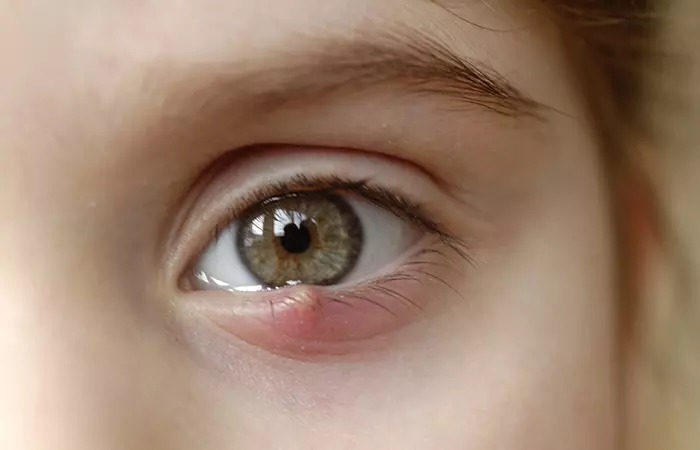
Some of the signs and symptoms of an eye stye are:
- Swelling of the eyes
- Burning sensation
- Pain in the eyes
- Blurred vision
- Eye tenderness and redness
- Itching
- Crustiness or discharge around the affected eye
- Sensitivity to light
- A feeling of having something in the eye, even when it is clear
Sometimes, the red bump is filled with pus which, if ruptured, can spread the infection. Sometimes, it may also bleed. So, proper care must be taken to treat this eye condition as soon as possible. In case the styes reoccur, consult a doctor at the earliest (1, 2).
Key Takeaways
- Use salt water to wash the affected area and reduce inflammation.
- Warm compression for 10-15 minutes on the affected eye reduces pain and swelling.
- Properly applying aloe vera, tea bags, potatoes, castor oil, and turmeric provides relief because of their antibacterial and anti-inflammatory properties.
- Seek medical advice if the symptoms prevail and the situation worsens.
Causes For Eye Stye
Some of the causes that lead to the formation of eye styes are:
- Sleep deprivation
- Dehydration
- Poor nutrition
- Poor hygiene (1)
- Using expired cosmetics
- Changing contact lenses without washing hands
- Not removing eye makeup before going to sleep
Home Remedies For Eye Stye
1. Coriander Seeds For Eye Stye
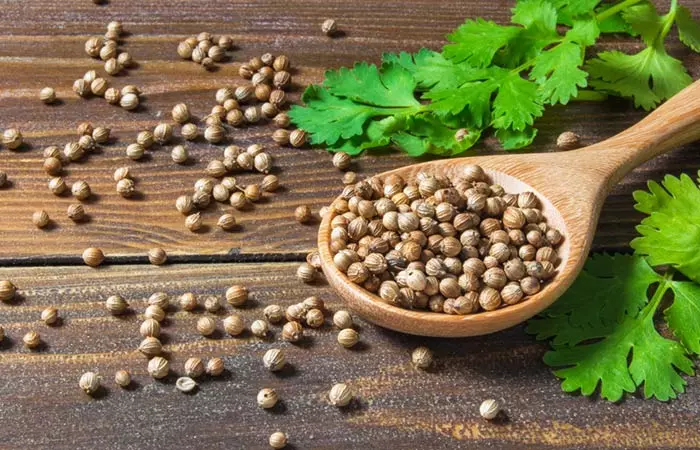
You Will Need
- 2 tablespoons coriander seeds
- 1 cup water
What You Have To Do
- Boil the coriander seeds in water for a few minutes.
- Strain this water and let it cool.
- Wash the affected eye with it.
How Often You Should Do This
Do this twice or thrice a day, and your stye will heal in no time.
Why This Works
The best-recommended home remedy for an eye stye is the use of coriander seeds.
They contain compounds that have anti-inflammatory properties and can reduce the edema in your eye (3).
2. Tea Bags For Eye Stye
You Will Need
- A tea bag
- Warm water
What You Have To Do
- Dip the tea bag in warm water for a minute.
- Remove the extra water and place this tea bag on the affected eye until the bag cools down.
If the stye is on the inside of the lid, place the bag over the lid. You can also use a used tea bag for this.
How Often You Should Do This
Repeat this 2-3 times in the day.
Why This Works
Warm tea bags are known to work wonders on a stye.
It not only gives relief from the pain but also helps reduce the swelling within 48 hours (4).
3. Guava Leaves For Eye Stye
You Will Need
- 5-6 guava leaves
- Water
- Soft cloth
What You Have To Do
- Boil the guava leaves for 5-7 minutes. Let it cool down a bit.
- Dip the cloth in this water and place it on the eye stye for about 15 minutes.
How Often You Should Do This
Repeat this 2-3 times.
Why This Works
This not only heals the stye but also provides relief from pain and swelling. This is because the guava leaves possess anti-inflammatory properties. They are also antimicrobial in nature and will prevent the eye from getting infected (5).
4. Garlic Juice For Eye Stye
You Will Need
- 1 garlic clove
- Q-tip
What You Have To Do
- Crush the garlic clove and apply the juice that oozes out carefully on the stye using a Q-tip.
- Wash it off with lukewarm water after it is dry.
How Often You Should Do This
Do this twice in the day.
Why This Works
Garlic juice is well known to cure an eye stye infection, thanks to its antibacterial properties
(6). It will not only give relief from the pain but also reduce the stye. Also, garlic is one of the most common home remedies for staph infection management, a condition that may also cause a stye to form and blepharitis (inflammation around the eyes).
Caution
Ensure the juice does not enter the eyes as it may sting a little.
5. Cloves Or Clove Oil For Eye Stye
You Will Need
- 2-3 cloves
- Water
What You Have To Do
- Grind the cloves to get a smooth paste.
- Apply it from one corner of the eyelash to the other end. Apply a little on the stye too.
- Leave it for a few hours to dry, and you will notice a drastic change.
You can also apply some clove oil instead of the cloves paste, with the help of a Q-tip.
How Often You Should Do This
Apply this twice a day.
Why This Works
This is another disinfectant that works wonders on a stye. Its antimicrobial properties can be made use of along with the antioxidants it contains to fasten the healing process (7).
Caution
The cloves may cause a burning sensation if they enter your eyes. So, be on guard.
6. Potato For Eye Stye
You Will Need
- 1 small potato
- A soft cloth
What You Have To Do
- Peel and grate the potato. Place this in a cloth and wrap the cloth around it.
- Place this cloth on the affected eye for 10-15 minutes.
How Often You Should Do This
This must be repeated twice a day for best results.
Why This Works
Potato is a mild astringent and has anti-inflammatory compounds (8), (9). This poultice will reduce the swelling, the pain, and also prevent infection.
Kevin Weiskirch, a blogger, discusses his utilization of potatoes for treating a stye. He writes, “After realizing that copious amounts of Advil and allergy meds weren’t gonna help make it actually go away, I finally booked an appointment at NYU’s an eye doctor. They told me it was a stye, and that the best way to treat it would be to warm up potatoes and put them on my eyes until the potato cooled off at least once or twice a day until the stye finally disappeared (i).”
7. Turmeric For Eye Stye
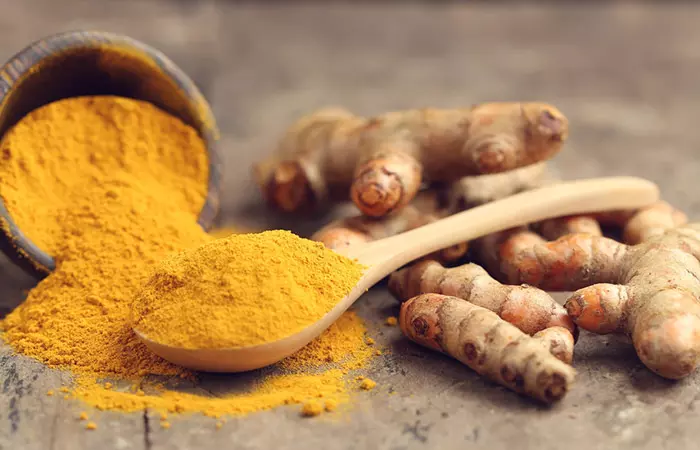
You Will Need
- A pinch of turmeric powder
- A glass of water
What You Have To Do
Mix the turmeric in the water and rinse your eye with this.
How Often You Should Do This
Do this twice a day to get fast relief.
Why This Works
Turmeric is an excellent antiseptic and is often used for treating topical and internal infections. This herb is also known for its healing properties (10).
 Quick Tip
Quick Tip8. Water And Salt For Eye Stye
You Will Need
- 1 liter water
- 2 teaspoons salt
- A soft cloth or face towel
What You Have To Do
- Boil the water and add the salt into it.
- Let the water cool a little, and then dip a towel or soft cloth in it.
- Compress the affected area with the water and leave it there for 20 minutes until the towel is no longer warm.
How Often You Should Do This
Do this twice a day until the stye is healed.
Why This Works
The warmth of the water will soothe the irritating eye stye. It will reduce the pain and also the swelling by promoting circulation (11). Salt in this remedy acts as an antimicrobial agent (12).
9. Cooked Egg For Eye Stye
You Will Need
1 hard-boiled egg
What You Have To Do
- Place the egg over the stye.
- Leave it over the stye for 10 to 15 minutes.
How Often You Should Do This
Repeat this twice a day.
Why This Works
Applying heat to the stye helps in reducing the swelling. It also relieves the pain. The heat from the egg heals the stye quickly.
10. Aloe Vera For Eye Stye
You Will Need
An aloe vera leaf
What You Have To Do
- Cut out the pulp from the aloe vera leaf by removing the scaly material outside.
- Place the pulp over the eye and leave it there for a few minutes.
- Rinse the eye with clean water after this.
How Often You Should Do This
This stye treatment offers quick relief cure when used 2-3 times a day.
Why This Works
Aloe vera is usefulfor treating sore eyes. This plant provides various health benefits. It will hydrate the eye while soothing the itching and the pain (13).
 Quick Tip
Quick Tip11. Acacia Leaves For Eye Stye
You Will Need
- A small bunch of acacia leaves
- Water
What You Have To Do
- Boil a few acacia leaves in water.
- Drain out the leaves and then use the water to rinse the eyes.
How Often You Should Do This
Do this twice a day.
Why This Works
If you have a painful stye, then acacia leaves might be the answer to your problem. The soreness of the eye and swelling will be healed in no time (14).
12. Onion Rings For Eye Stye
You Will Need
Onion slices
What You Have To Do
Cut an onion into slices and place the slices over the eyes for a few minutes.
How Often You Should Do This
Do this twice a day.
Why This Works
Onions do not help to get rid of an eye stye completely but they do assist in reducing the pain. Although it creates a burning or stinging sensation, it speeds up the healing process. Onion has anti-inflammatory and antimicrobial properties too (15). Another useful way to use this root for a stye is to chop onions. When water comes out of the eyes because of the pungent fumes from the onion, it will naturally hydrate the eye and relieve the eye pain. It will also cleanse the eye of dirt and dust particles that may cause infection.
13. Tamarind For Eye Stye
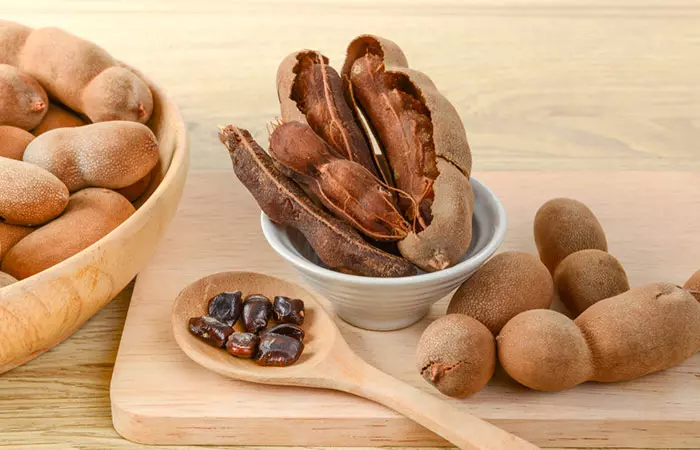
You Will Need
- A handful of tamarind seeds
- 2 cups of water
What You Have To Do
1. Soak tamarind seeds in water for 12 hours.
2. Then, use the drained out water to rinse the eye.
How Often You Should Do This
Do this twice a day to get relief.
Why This Works
Tamarind seeds are also used as an effective remedy for an eye stye as it helps relieve both pain and swelling (16).
14. Iron Or Gold For Eye Stye
You Will Need
Any item made of iron or gold
What You Have To Do
Gently rub this item over the stye for a couple of seconds.
How Often You Should Do This
Repeat a few times during the day.
Why This Works
According to anecdotal evidence this natural remedy is effective to cure the stye when used in the early stages. It is an old wives’ tale that has worked for many people.
Caution
One should pay attention to the kind of metal used. Dirty or rusted metal can cause an infection. Always use a clean and hygienic item only.
15. A Coin For Eye Stye
You Will Need
A coin
What You Have To Do
- Wash the coin with antibacterial soap and water.
- Rub it against a clean, coarse cloth or in between your palms to warm it up.
- Place this warm coin on the stye until it cools down.
- Repeat this 1-2 times.
How Often You Should Do This
Do this a few times during the day.
Why This Works
The warmth of the metal will soothe the pain and give you immediate relief.
16. Milk Cream For Eye Stye
You Will Need
- 1 tablespoon fresh milk cream
- 1 tablespoon milk
- 4 tablespoons water
- A cotton ball
What You Have To Do
- Lightly warm up the milk cream. It should be warm enough to sting the eye a little. But at the same time, it should be bearable.
- Apply this warm milk on the eye, concentrating over the stye, using the cotton.
- Once it is dry, use the milk mixed with water to clean the area. Wipe it dry with a clean towel.
How Often You Should Do This
Do this twice a day until the eye stye heals.
Why This Works
The warmth of the milk cream reduces the swelling and also help in quickly eliminating any pus that may be present (11).
Caution
During this home treatment, dust particles should not enter the eye.
17. Bitter Gourd For Eye Stye
You Will Need
Bitter gourd
What You Have To Do
- Cut slices of the gourd and apply it directly on the stye.
- Leave the slices on the eyes for 15 minutes. Remove them and wash the area.
Another method to use bitter gourd is by brewing a tea out of the gourd. Drink this bitter gourd tea in the morning on an empty stomach. You can add a pinch of salt for taste.
How Often You Should Do This
Repeat the bitter gourd application twice a day.
Why This Works
Bitter gourd works as a detoxifying agent. It will help in cleansing your skin and removing the stye effectively. You can also use the leftover gourd particles from the tea as a compress. This will help in alleviating the pain. Bitter gourd is also antibacterial in nature (17).
18. Castor Oil For Eye Stye
You Will Need
- Castor oil
- Cotton swab
What You Have To Do
- Dip the cotton swab in the oil and apply this on the affected area.
- Rub it a little but take care not to puncture the stye.
- Leave the oil on for 15 minutes and then wash it off with lukewarm water.
How Often You Should Do This
Repeat the process a few times in the day until the stye is healed.
Why This Works
Castor oil, with hydrating properties, is useful to cure infections of the skin. It reduces the swelling and pain while treating any infection that may be causing the stye with its antimicrobial properties (19).
19. Bread And Milk For Eye Stye
You Will Need
- A slice of bread
- Warm milk
- Cotton
- Antiseptic ointment
What You Have To Do
- Take a clean and fresh bread slice. Cut the bread double the size of the eye.
- Soak the bread in warm milk and place it over the eyes for 15-20 minutes. This will make the stye rupture.
- If it does not, leave it on for a little longer.
- When the pus comes out, clean it with cotton, and then apply an antiseptic ointment to prevent infection.
How Often You Should Do This
Repeat this once again if required.
Why This Works
This is one of the oldest eye stye home remedy, almost an old wives’ tale. The warmth of the milk is supposed to help rupture the stye. Many people have benefitted from this remedy.
Caution
Do not use milk that is too hot as this may burn the sensitive skin around the eyes easily.
20. Apple Cider Vinegar
You Will Need
- 2 teaspoons apple cider vinegar
- 1 cup hot water
- Cotton ball
What You Have To Do
- Dilute the ACV in water.
- Soak the cotton ball in this mixture. Squeeze out the excess liquid and place this over the stye for a minute or two.
How Often You Should Do This
Repeat this 2-3 times a day.
Why This Works
Apple cider vinegar has antimicrobial and anti-inflammatory properties. It reduces the swelling and infection. Its low acidity will heal the eye stye quickly (19), (20).
Caution
The vinegar will sting slightly. In case, the solution hurts a lot, immediately remove the cotton ball and rinse the eye thoroughly with cool, clean water.
21. Coconut Oil For Eye Stye
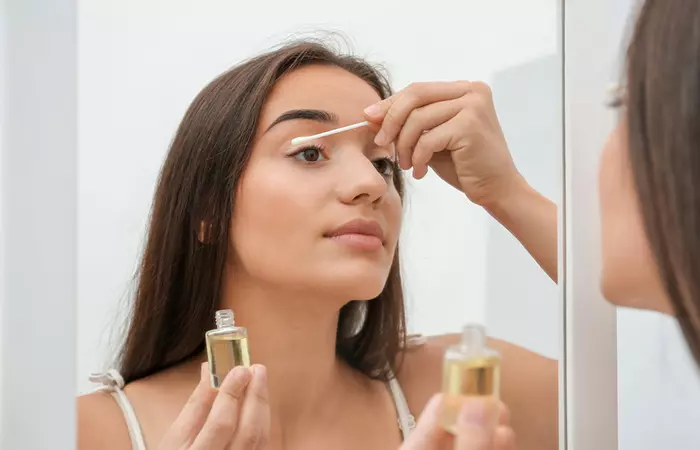
You Will Need
- Coconut oil
- Q-tip
What You Have To Do
- Rinse the affected eye with clean water.
- Lightly warm the coconut oil and apply it using the Q-tip to the stye and tear duct area.
- Leave the oil on for as long as possible.
How Often You Should Do This
Keep reapplying the coconut oil throughout the day.
Why This Works
Coconut oil will keep the skin hydrated and reduce the swelling. It will also kill the bacteria causing the eye infection (21), (22).
22. Tea Tree Oil For Stye Eye
You Will Need
- 4-5 drops tea tree oil
- 2 tablespoon clean water
What You Have To Do
- Add the oil to the water and mix well. Place this mixture in the fridge so that it stays cool.
- Apply a drop or two of this to the affected area and leave it on.
How Often You Should Do This
Do this 2-3 times every day until the stye heals.
Why This Works
Tea tree oil is an excellent antimicrobial agent that is often used to treat topical infections. It has antibacterial, antifungal, antiviral, and antiparasitici A group of medications used in the management or treatment of infections caused by parasites. properties. It is also good at reducing inflammation and promotes healing (23).
23. Warm Compress For Eye Stye
You Will Need
- A small soft cloth
- Hot water
What You Have To Do
- Soak the cloth in hot water. Remove and wring out the excess water.
- Once the temperature of the cloth is bearable, place it on the affected eye. Keep your eyelid closed.
- Keep the cloth on until it comes down to room temperature.
- Repeat the above process once again.
How Often You Should Do This
Apply the warm compress 4-5 times daily.
Why This Works
The warm compress will soften the eye stye and will help it to drain by itself (24).
24. Epsom Salt For Eye Stye
You Will Need
- 1 cup warm water
- 1 teaspoon Epsom salt
- Washcloth
What You Have To Do
- Mix the salt well in the water.
- Soak the washcloth in this, wring out the excess, and place it on the affected eye.
- Leave it on for 10-15 minutes.
How Often You Should Do This
This remedy will yield best results if repeated 3-4 times a day.
Why This Works
Epsom salt works as an astringenti A substance or chemical agent that helps shrink tissues and dry up skin secretions to tighten pores. and cleanses the area (25). It gives relief from the pain (26). The warmth of the water will help to reduce the stye in no time.
25. Lavender Oil For Eye Stye
You Will Need
Lavender oil
What You Have To Do
- Carefully apply a drop of lavender essential oil to the eye stye.
- Leave the oil on.
You can also add a drop of frankincense oil to the lavender oil and use it.
How Often You Should Do This
Repeat this 2-4 times daily.
Why This Works
Lavender oil is very cooling and soothing for the inflamed and irritated skin at the affected region. It also has antifungal and antibacterial properties (27).
Caution
For children, dilute the oil either with water or coconut oil.
26. Honey For Eye Stye
You Will Need
- 3 tablespoons honey
- 2 cups of hot water
What You Have To Do
- Mix the honey thoroughly in water and bring down the temperature of water to warm.
- Rinse the affected eye with this.
How Often You Should Do This
Repeat this twice a day.
Why This Works
Honey is an emollienti A substance or agent that moisturizes the skin by forming a protective film over it to trap moisture. that keeps the skin moisturized. This property is beneficial in reducing the itching sensation in the affected area. Its antimicrobial, anti-inflammatory, and anti-allergen properties are useful for treating skin conditions like eye stye (28). Honey may also help manage symptoms of other eye issues and is one of the effective home remedies for eye infections such as blepharitis, keratoconjunctivitis, etc.
Some home remedies can cure and heal an eye stye. But remember that some of these eye stye home remedies will only work in the initial stages when the stye in the eye has formed, and there is no infection. Use remedies with antimicrobial components such as castor oil, essential oils, turmeric, and garlic for infected eye stye treatment.
These remedies should offer relief in most cases. In addition, gently massaging the eyelid with clean fingers or a warm compress may help unblock oil glands. Stimulating pressure points around the eyes may also relieve pain and improve circulation. However, you also may need to visit a doctor or go for medical treatments if the condition worsens or doesn’t get better.
Medical Treatments For Eye Stye
To treat an eye stye, doctors might suggest a few different approaches. Topical antibiotics can be applied directly to the stye to help clear the infection. For more serious cases, oral antibiotics might be needed to treat the infection from inside the body. If the stye does not improve or keeps coming back, a doctor might need to drain it with a small procedure. This helps reduce pressure and speed up healing. It is important to follow your doctor’s instructions and take any prescribed medication correctly to make sure the infection is completely eliminated.
An eye doctor may suggest a corticosteroid injection for styes with a high level of inflammation. This treatment may speed up recovery and reduce swelling, especially for internal styes. A simple surgical operation may be performed by an ophthalmologist if a stye grows too big, uncomfortable, or does not drain on its own. So, when do you have to visit a doctor? Keep reading to know more.
When To See A Doctor
A stye is a minor issue that can easily be managed at home. However, consult a doctor if it affects your vision, does not improve within a week of using home remedies, or you develop multiple styes in a short period. Symptoms like redness, swelling, or high fever are signs of a potentially serious infection that warrants immediate medical attention. Moreover, seek medical advice promptly if you have a history of recurrent styes, diabetes, or a weakened immune system. If you ignore the ongoing or worsening symptoms, it might lead to more severe health issues. Prompt medical care makes sure that any underlying problems are addressed properly. It helps you recover quickly and effectively.
Here are a few pointers to keep in mind to prevent styes and other eye infections as well.
Precautions
- Avoid touching the affected area. If you do, wash your hands beforehand.
- Avoid sharing personal items and cosmetics.
- Pay attention to the proper hygiene of your eyes and wash them at least three times a day.
- Always use clean water to rinse the eyes.
- If you use contact lenses, keep them clean and put them on with clean hands.
- Do not rupture the stye as it will lead to infection.
- Do not wear eye makeup or contact lenses when you have an eye stye.
- Remove makeup before going to bed.
- Replace eye makeup, such as eyeliners and mascara every 3-4 months.
- Sleep at least 6-8 hours daily.
- Avoid stress as it can lower immunity levels and trigger infections easily.
- Use good quality medicine for treating an eye stye. For recurrent styes, use antibiotici A substance or agent active against bacteria and useful in preventing its growth and proliferation. creams or eye drops. Over-the-counter medications and painkillers like paracetamol and ibuprofen relieve pain. Topical antibiotics or oral antibiotics help in taking care of the infection. If the external stye is extremely painful, the doctor may remove the eyelash nearest to it and drain the pus away by lancing it with a thin needle. This drainage procedure should only be done by an ophthalmologist.
- Avoid wearing makeup, lotions, or contact lenses until the stye is gone.
Infographic: Dos & Don’ts When You Have A Stye
Styes are common and do not always need medical intervention. But they may be painful and unsightly. While home remedies can help treat this condition effectively, they may spread to others, causing further infections if you don’t take proper care. Therefore, you should be careful when you have a stye.
Check out the infographic below to learn about the dos and don’ts when you have a stye.
Some thing wrong with infographic shortcode. please verify shortcode syntax
Eye styes resemble pus-filled red bumps and form on eyelids when glands bordering the eyelids get clogged. Swelling, pain, blurred vision and itchiness are common symptoms that may accompany an eye stye. Many factors like sleep deprivation, nutritional deficiencies, dehydration, expired cosmetics, and unhygienic use of contact lenses may trigger this condition. However, eye styes are quite commonplace and can be treated at home in the early stages or surgically removed by a medical professional. Home remedies for eye stye include the use of coriander seeds, tea bags, metals like iron and gold, turmeric, cloves, bitter gourd, and other easily available ingredients. An eye stye may become infected or burst if left untreated, so prompt action and maintaining eyelid hygiene is recommended.
Frequently Asked Questions
Can a dirty pillow cause a stye?
Dr. Ranjodh S Boparai, MD, an ophthalmic surgeon at the U.S. Department of Veterans Affairs, says, “While sleeping on a dirty pillow may not cause styes directly, it can certainly introduce new pathogens, such as bacteria, or your eyelids and lashes, predisposing you to develop a stye.”
Is putting ice on a stye good?
According to Dr. Boparai, “No, styes respond best to warm compresses. Since styes form from blocked oil glands, a warm compress can help liquefy the backed-up oil and help a stye naturally drain.”
Should you massage a stye?
“Yes, gently massaging the stye with a warm compress may help enhance the breaking up of the backed-up oil and help the stye drain,” says Dr. Boparai.
Does a hot shower help a stye?
Dr. Boparai says, “Yes, for the same reasons that a warm compress helps. The heat helps to liquify the backed-up oil. Although, a warm compress is a more effective way of delivering heat directly to the stye, compared to a warm shower.”
Do styes naturally go away?
Yes, styes usually get smaller and go away naturally in a few weeks. However, in some cases, styes may persist and require surgery and other treatments to clear up.
How long will a stye last?
Styes usually last up to 2 weeks.
Are styes contagious?
No, styes are not contagious. However, as styes may be caused due to bacterial infection, some transfer of bacteria to other people is possible.
Does a stye get bigger before it goes away?
No. A stye usually diminishes in appearance before going away. However, putting a warm compress on a stye may temporarily make it appear bigger.
How to get rid of a stye overnight?
While getting rid of a stye overnight may not be guaranteed, there are several stye self-care measures and home remedies for stye, you can try to alleviate discomfort and promote faster healing. These include using essential oil compresses, and Epsom salt rinse for the eye, maintaining good eye hygiene, and avoiding using eye makeup.
Illustration: How To Get Rid Of A Stye - 26 Home Remedies And Precautions
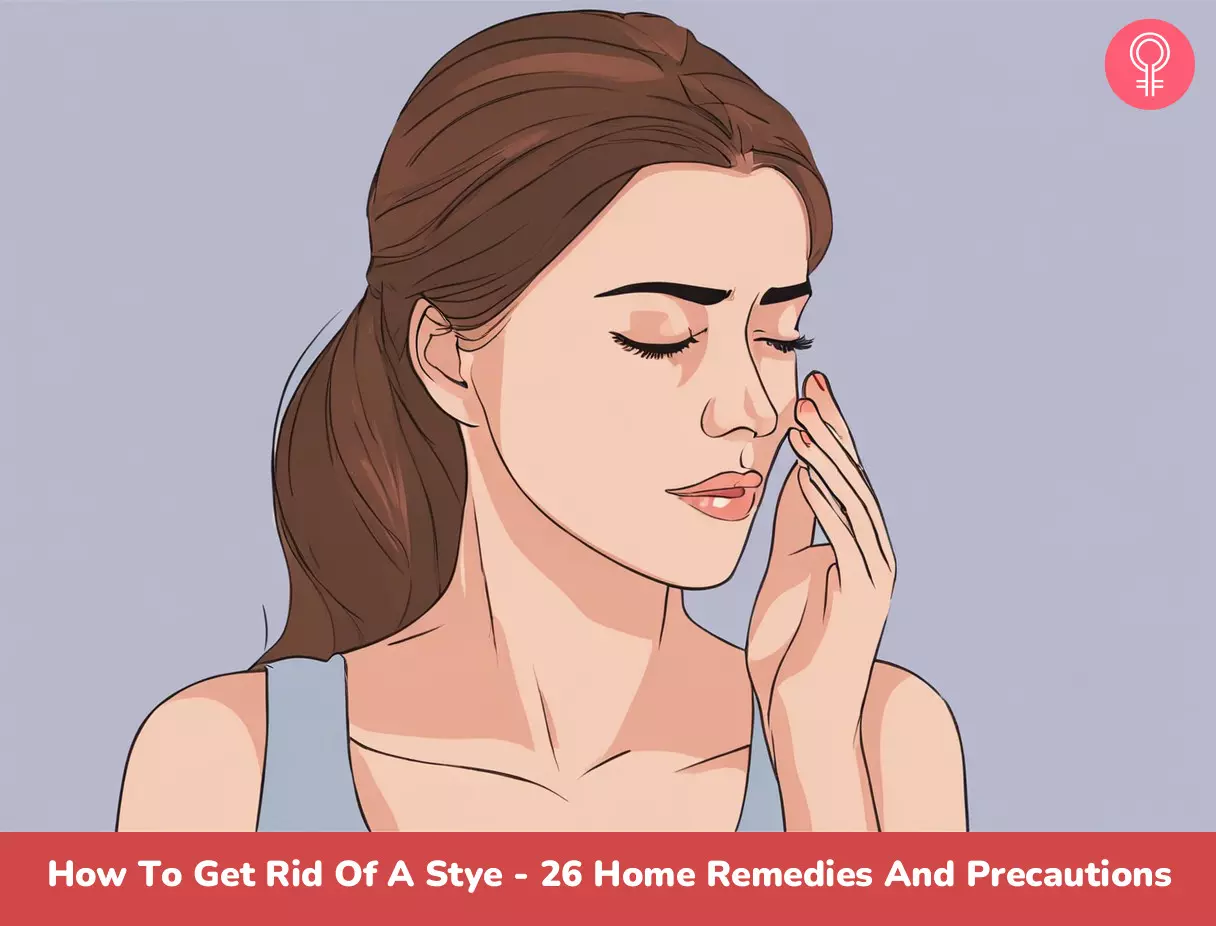
Image: Stable Diffusion/StyleCraze Design Team
Want tips on how to reduce swelling and discomfort? Learn how to quickly and easily get rid of a stye with this helpful video!
Personal Experience: Source
StyleCraze's articles are interwoven with authentic personal narratives that provide depth and resonance to our content. Below are the sources of the personal accounts referenced in this article.
i. Hot Potato, Hot Potato: My Experience with the NYU Optometristhttps://nyulocal.com/hot-potato-hot-potato-my-experience-with-the-nyu-optometrist-a6371aae4bdc
References
Articles on StyleCraze are backed by verified information from peer-reviewed and academic research papers, reputed organizations, research institutions, and medical associations to ensure accuracy and relevance. Read our editorial policy to learn more.
- Hordeolum
https://pubmed.ncbi.nlm.nih.gov/28723014/ - Hordeolum
https://www.sciencedirect.com/topics/pharmacology-toxicology-and-pharmaceutical-science/hordeolum - Antioxidant Anti-Inflammatory and Antidiabetic Proprieties of LC-MS/MS Identified Polyphenols from Coriander Seeds
https://pubmed.ncbi.nlm.nih.gov/33477662/ - Can warm tea bag compresses help reduce infections of the eye?
https://www.aao.org/eye-health/ask-ophthalmologist-q/warm-tea-bag-compress - Psidium guajava: A review on its potential as an adjunct in treating periodontal disease
https://www.ncbi.nlm.nih.gov/pmc/articles/PMC4127827/ - Antimicrobial properties of allicin from garlic
https://pubmed.ncbi.nlm.nih.gov/10594976/ - Clove (Syzygium aromaticum): a precious spice
https://www.ncbi.nlm.nih.gov/pmc/articles/PMC3819475/ - Anti-inflammatory properties of potato glycoalkaloids in stimulated Jurkat and Raw 264.7 mouse macrophages
https://pubmed.ncbi.nlm.nih.gov/23454444/ - Protease Inhibitors from Plants with Antimicrobial Activity
https://www.ncbi.nlm.nih.gov/pmc/articles/PMC2705521/ - Curcumin a Natural Antimicrobial Agent with Strain-Specific Activity
https://www.ncbi.nlm.nih.gov/pmc/articles/PMC7408453/ - Mechanisms and efficacy of heat and cold therapies for musculoskeletal injury
https://pubmed.ncbi.nlm.nih.gov/25526231/ - Antimicrobial properties of salt (NaCl) used for the preservation of natural casings
https://pubmed.ncbi.nlm.nih.gov/16943065/ - ALOE VERA: A SHORT REVIEW
https://www.ncbi.nlm.nih.gov/pmc/articles/PMC2763764/ - Effect of ethanolic extract of Acacia auriculiformis leaves on learning and memory in rats
https://www.ncbi.nlm.nih.gov/pmc/articles/PMC4080506/ - Therapeutic Uses and Pharmacological Properties of Garlic Shallot and Their Biologically Active Compounds
https://www.ncbi.nlm.nih.gov/pmc/articles/PMC3874089/ - Review of unique ophthalmic formulations in Vaidya Manorama: A traditional Kerala Ayurveda literature
https://www.ncbi.nlm.nih.gov/pmc/articles/PMC9168494/ - Bitter melon: a panacea for inflammation and cancer
https://www.ncbi.nlm.nih.gov/pmc/articles/PMC5276711/ - Effect of ricinoleic acid in acute and subchronic experimental models of inflammation.
https://www.ncbi.nlm.nih.gov/pmc/articles/PMC1781768/ - Anti-obesity and anti-inflammatory effects of synthetic acetic acid vinegar and Nipa vinegar on high-fat-diet-induced obese mice
https://www.ncbi.nlm.nih.gov/pmc/articles/PMC5532206/ - Acetic acid and the skin: a review of vinegar in dermatology
https://pubmed.ncbi.nlm.nih.gov/34350993/ - A randomized double-blind controlled trial comparing extra virgin coconut oil with mineral oil as a moisturizer for mild to moderate xerosis
https://pubmed.ncbi.nlm.nih.gov/15724344/ - Novel antibacterial and emollient effects of coconut and virgin olive oils in adult atopic dermatitis
https://pubmed.ncbi.nlm.nih.gov/19134433/ - Melaleuca alternifolia (Tea Tree) Oil: a Review of Antimicrobial and Other Medicinal Properties
https://www.ncbi.nlm.nih.gov/pmc/articles/PMC1360273/ - Interventions for acute internal hordeolum
https://www.ncbi.nlm.nih.gov/pmc/articles/PMC3424070/ - Bathing Practices in Dermatology: Uses and Implications for Patient Management
https://www.ncbi.nlm.nih.gov/pmc/articles/PMC10506818/ - Bathing in a magnesium-rich Dead Sea salt solution improves skin barrier function enhances skin hydration and reduces inflammation in atopic dry skin
https://pubmed.ncbi.nlm.nih.gov/15689218/ - Biological activities of lavender essential oil
https://pubmed.ncbi.nlm.nih.gov/12112282/ - Medicinal and cosmetic uses of Bee’s Honey – A review
https://www.ncbi.nlm.nih.gov/pmc/articles/PMC3611628/ - Stye
https://www.ncbi.nlm.nih.gov/books/NBK459349/
Read full bio of Dr. Bhakti Kapse
- Dr. Ranjodh S Boparai, MD, is an ophthalmic surgeon at the U.S. Department of Veterans Affairs. He has 5 years of experience and aims to spread awareness about the importance of eyecare. He has authored 50+ publications on biomedical research, received 20+ awards and scholarships, and granted 10+ research fellowships.
 Dr. Ranjodh S Boparai, MD, is an ophthalmic surgeon at the U.S. Department of Veterans Affairs. He has 5 years of experience and aims to spread awareness about the importance of eyecare. He has authored 50+ publications on biomedical research, received 20+ awards and scholarships, and granted 10+ research fellowships.
Dr. Ranjodh S Boparai, MD, is an ophthalmic surgeon at the U.S. Department of Veterans Affairs. He has 5 years of experience and aims to spread awareness about the importance of eyecare. He has authored 50+ publications on biomedical research, received 20+ awards and scholarships, and granted 10+ research fellowships.
Read full bio of Kushneet Kukreja
Read full bio of Ramona Sinha
Read full bio of Swathi E






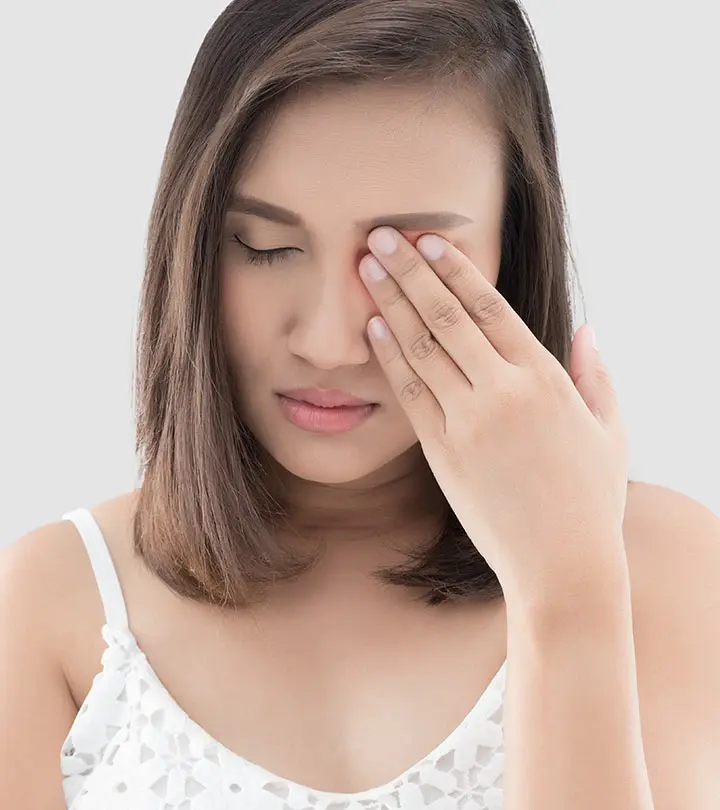
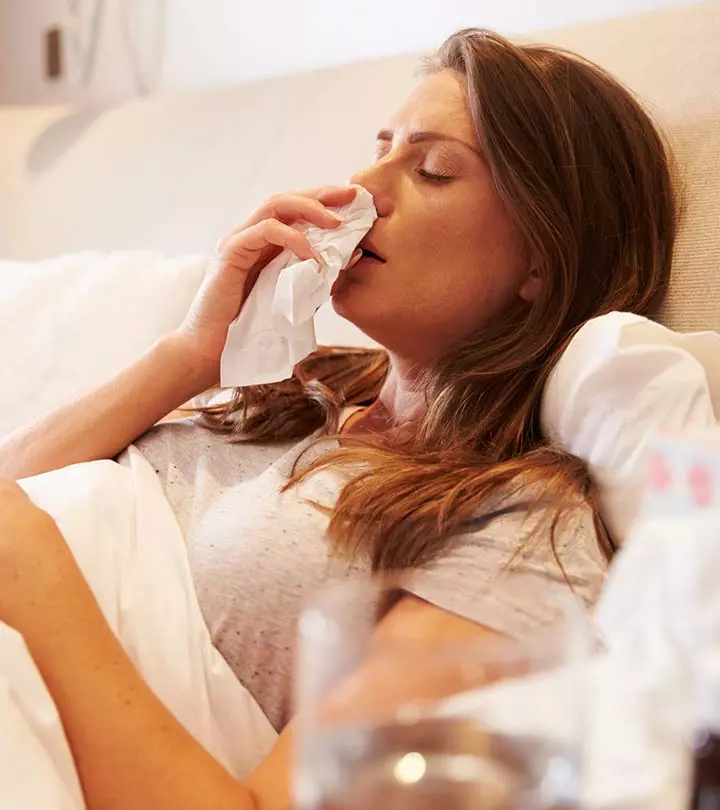
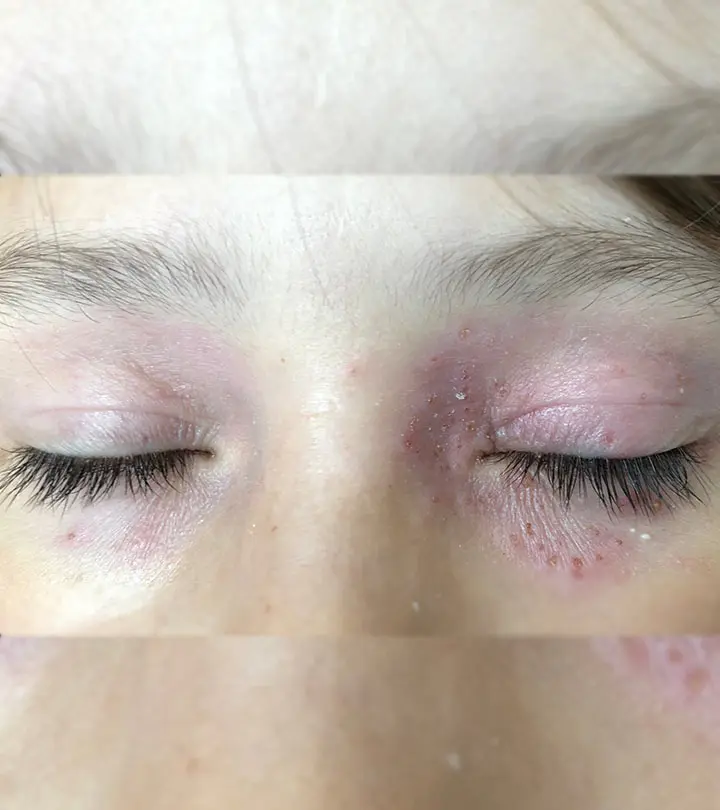

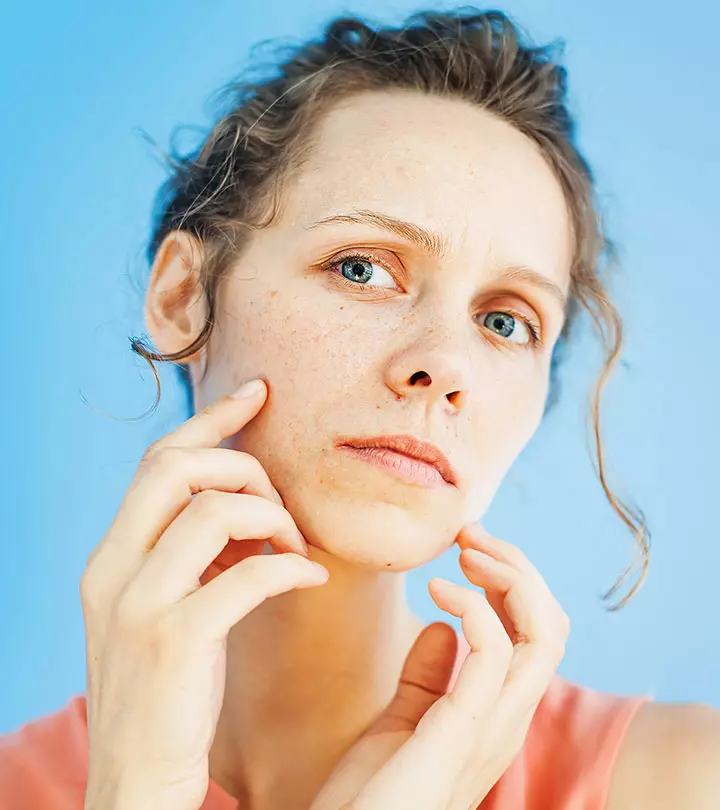
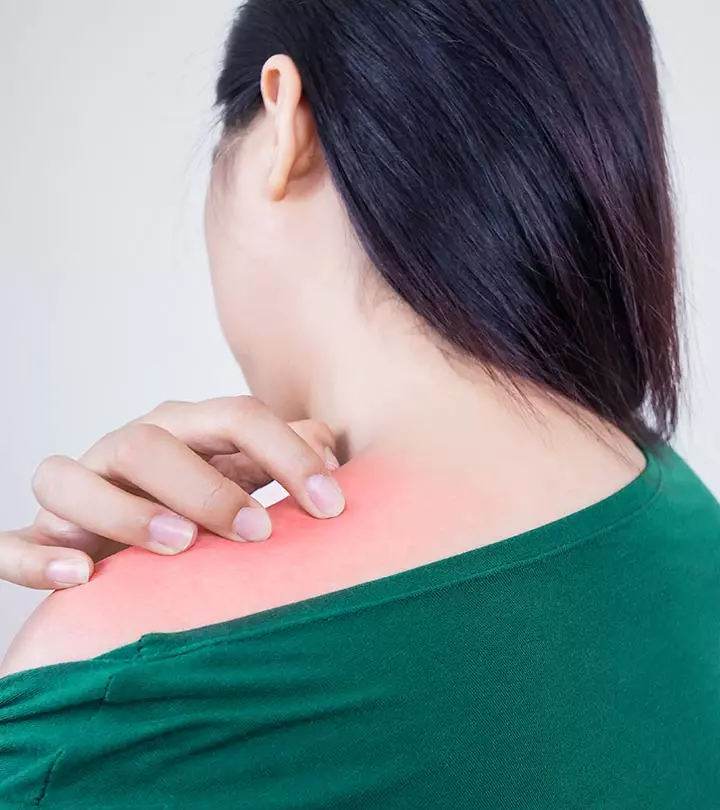

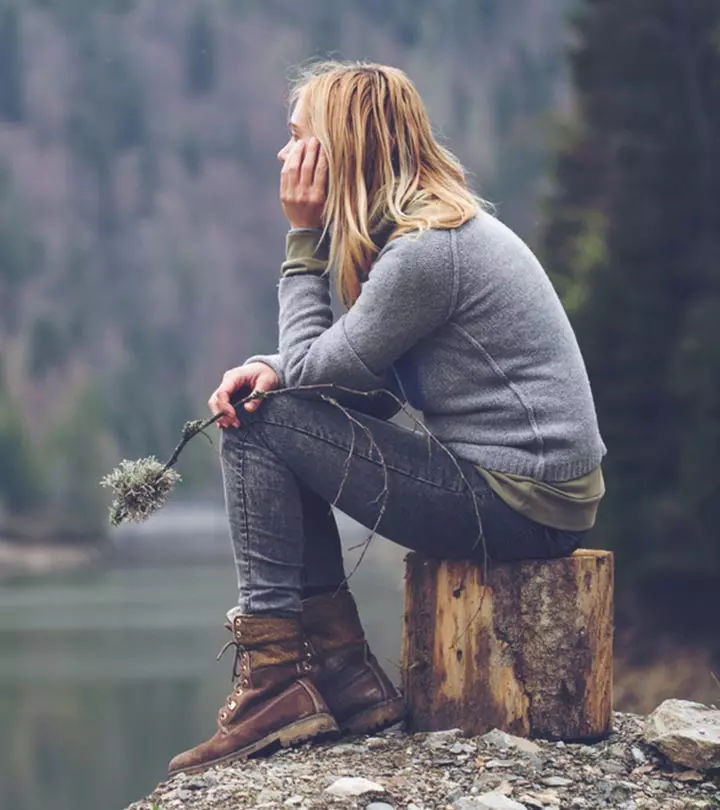

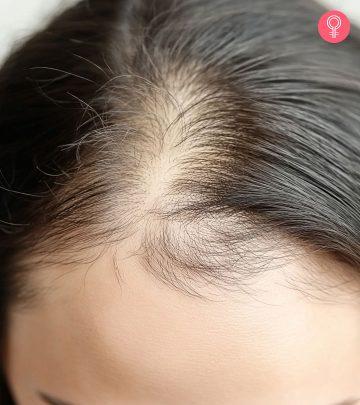



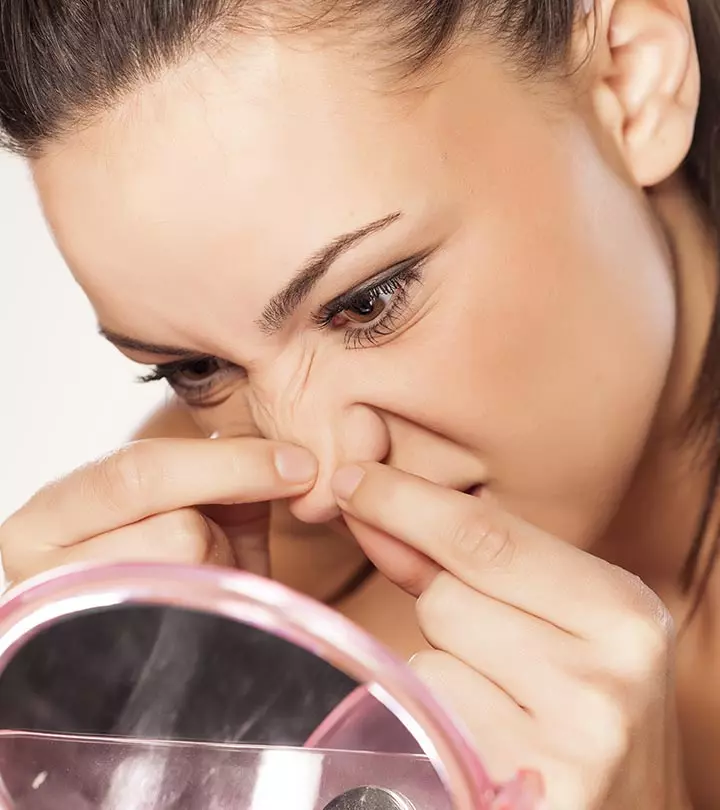

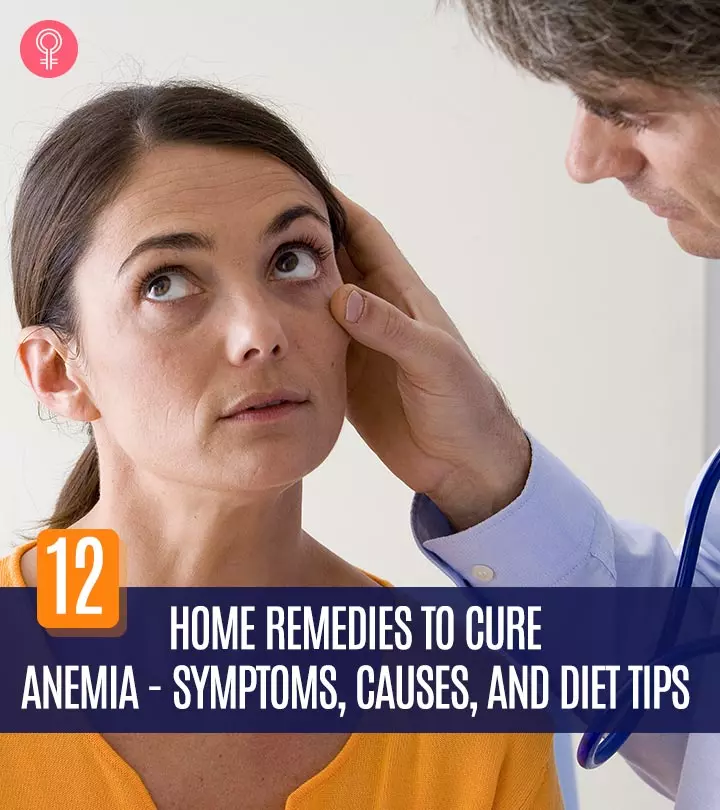
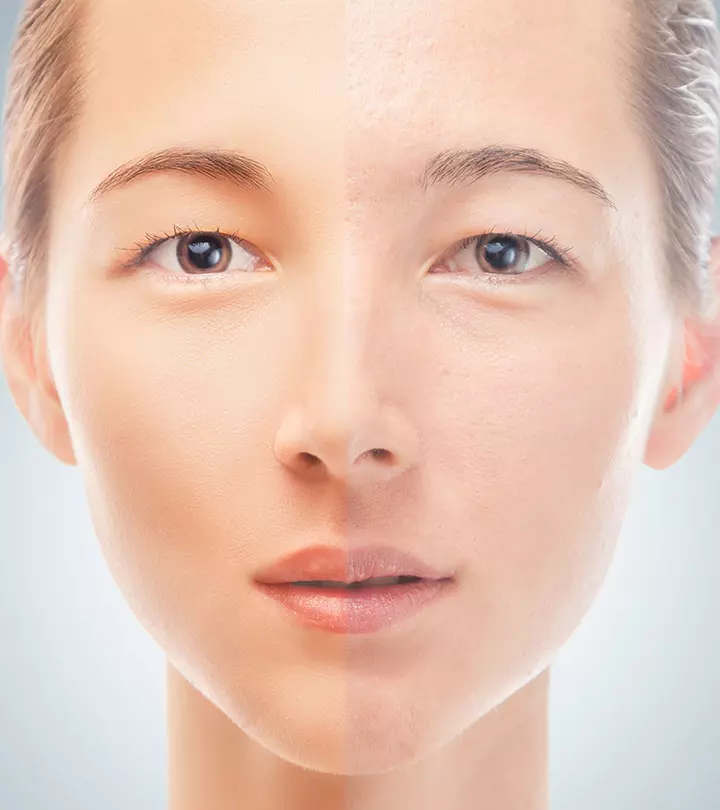




Community Experiences
Join the conversation and become a part of our empowering community! Share your stories, experiences, and insights to connect with other beauty, lifestyle, and health enthusiasts.